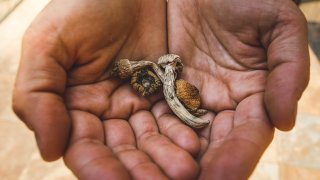
The Psychedelics and Health Research Initiative at UC San Diego received a $1.3 million grant from the Steven & Alexandra Cohen Foundation to fund a clinical trial investigating the therapeutic potential of psilocybin in treating phantom limb pain.
Psilocybin is a naturally occurring psychedelic compound produced by many species of fungus, including so-called "magic mushrooms.'' Phantom limb pain is pain originating from parts of the body no longer present, such as an amputated arm or leg. It is a form of neuropathic pain that actually originates in the spinal cord and brain.
The grant will fund the first randomized, placebo-controlled human clinical trial examining the safety and efficacy of psilocybin in patients suffering from chronic phantom limb pain. The trial is also designed to explore the brain mechanisms involved, including possible alterations in brain circuitry.
The trial is part of the PHRI, whose mission is to study the potential of psilocybin and related compounds in treating pain and promoting healing.
"The therapeutic potential of psilocybin is unique among pharmaceutical agents that are used as analgesics,'' said Dr. Timothy Furnish, a clinical professor of anesthesiology at UCSD School of Medicine and a co-principal investigator in the trial.
"Most analgesic drugs are taken at least daily to treat the symptoms of chronic pain, but they do nothing to change the underlying pathology,'' he said. "Psilocybin has the potential to 'reset' altered cortical brain circuits associated with certain chronic pain conditions. This reset could result in a drug that works on an extended basis (days or weeks) or perhaps even constitutes a "cure.'''
Research at UCSD on psychedelics began in the 1970s with the work of Mark Geyer, a professor of psychiatry and neurosciences emeritus and co-founder of the PHRI. Geyer conducted basic research on the behavioral and neurobiological effects of psychedelics at UCSD.
Local
The PHRI has a briefer history, originating in 2016 with Albert Yu-Min Lin, a research scientist at the Jacobs School of Engineering and Qualcomm Institute, who lost his lower right leg in an off-road vehicle accident. During recovery and rehabilitation, Lin experienced serious, recurrent phantom limb pain.
"The pain wasn't subtle,'' Lin said. "It was like being in the heart of a trauma all of the time. It was all consuming, but coming from a part of the body that literally no longer existed. I was desperate. I felt like I was gasping for air in a pool, looking for relief.''
During recovery, Lin discovered the work of V.S. Ramachandran, a professor of psychology and neurosciences at UCSD, who had pioneered development of a therapy for treating phantom limb pain. The treatment involves using mirrors to create a reflective illusion of the limb, tricking the brain into thinking movement has occurred without pain or to create positive visual feedback of limb movement. For Lin, the therapy provided pain relief, but only while the mirror was in place. As a field researcher and explorer for the National Geographic Society, Lin had traveled the world helping develop technologies to assist in archeological digs and similar activities. He was aware that other cultures used plant-based preparations to produce mind-altering, therapeutic effects.
Lin procured some psilocybin, drove out to the desert, boiled it to create a tea and hooked up his leg mirror. He studied the illusion, removed the mirror, studied where his leg once had been and repeated the sequence, again and again.
Within 45 minutes, he said, there was relief.
"The pain was gone. I did handstands. It was a profoundly spiritual moment,'' Lin said. "My mind had a map of my body and it was experiencing severe feedback issues, but it had to let go of that map through a sort of 'state of ego death' in which the psilocybin allowed the mind to reject the old map and create a new one. Now, I occasionally have a jolt of pain, but it's mostly gone.''
But Lin also recognized that his experience was anecdotal and singular, and that more work was needed to help others in similar pain and circumstances. In 2018, Lin, Furnish, Ramachandran and others published a paper in Neurocase describing their collaboration, and in 2019, another account was published in the journal Regional Anesthesia & Pain Medicine.
The World Health Organization estimates that there are more than 40 million amputees in the world, with up to 80% experiencing phantom limb pain. Military veterans exhibit the highest rates of amputation and chronic phantom limb pain, according to previous studies.
Thirty amputees suffering from phantom pain will be enrolled in the three-year clinical trial. Half of the participants will receive 25 milligrams of psilocybin on two occasions; the other half will receive two doses of niacin.
Niacin was chosen as the placebo because it mimics some of the physical sensations that subjects may experience after taking psilocybin, but does not produce a "trip,'' according to Furnish. The trial will include multiple clinical visits to assess pain and psychological functioning, including magnetic resonance imaging.



